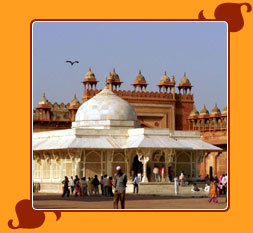Ajmer is an oasis wrapped in the green hills. The
city was founded by Raja Ajay Pal Chauhan in the 7th Century A.D. and
continued to be a major centre of the Chauhan power till 1193 A.D. When
Prithviraj Chauhan lost it to Mohammed Gaure. Since then, Ajmer became home
to many dynasties. Today, Ajmer is a popular pilgrimage centre for the
Hindus as well as Muslims.
Especially famous is the Dargah
Sharif-tomb of the Sufi saint Khwaja Moinuddin Chisti, which is equally
revered by the Hindus and Muslims. It is a centre of culture and education,
the British chose Ajmer for its prestigious Mayo College a school
exclusively for Indian nobility. Ajmer is also the base for visiting Pushkar
(14 km.), the abode of Lord Brahma, lying to its west with a temple and a
picturesque lake. The Pushkar Lake is a sacred spot for Hindus. During the
month of Kartik (Oct./Nov.), devotees throng in large numbers here to take a
dip in the sacred lake.
 Ajmer
Ajmer
was also favourite residence for the great Mughals. One of the first
contacts between the Mughal King Jahangir and Sir Thomas Roe took place here
in 1616. The Scindias took over the city in 1818 and then handed it over to
the British and it became one of the only part of Rajasthan controlled
directly by the East Indian Co.
The bus stand in Ajmer is located
near the RTDC hotel Khadim. And the railway is further north and most of the
hotels are west of the stations. Northeast is the main post office and most
of the cities market is located behind and up to Agra Gate. Further north is
a large artificial lake called the Anna Sagar.
History
of AjmerThis charming village has derived its name after Rana
Kumbha. Well-known for some excellently carved 15th century Jain temples in
amber stone, Ranakpur is one of the five holiest places of the Jains and
flaunts outstanding natural beauty. Dharna Sah, who happened to be a Jain
businessman, approached Rana Kumbha when he had the vision of his great
temple to request a portion of land for its construction.
The
magnificent Jain temples were built during the rule of the open-minded and
gifted monarch Rana Kumbha during the 15th century. The basement of the
complex covers 48,000 sq. feet area and features four additional shrines,
twenty four pillared halls and domes supported by more than four hundred
columns. There are 1,444 columns and all of them are intricately carved with
different appearance. The inventively engraved nymphs playing the flute in
various dance positions at an elevation of 45 feet makes for an absorbing
sight.
Place to SeeDargah
Khwaja Sahib: It is the landmark of Ajmer and one of the holiest of
Muslim shrines in the country. It has a secular appeal and revered by people
of all sect.
Khwaja Moin-ud-din Chisti, a Sufi saint from Persia
made this place his abode from 1192 till he died in 1236 AD. Mughal King
Humayun completed the construction of the shrine. The Dargah is approached
through a massive gate with silver doors built in several stages. Emperor
Akbar made an annual pilgrimage to Ajmer. Mughal Emperors Akbar and Shah
Zahan have built mosques in the complex. The saint's tomb is in the centre
of the second courtyard and the actual tomb inside is surrounded by a silver
railing and partly by a marble screen.
The tomb is of marble and
dome is gold plated. The atmosphere inside the shrine is charged and
supernatural with burning of incense and offerings of flowers mainly rose
and sweets As you enter the Dargah courtyard, you see two massive 'degs'
meaning cauldrons. Mughal Emperors Akbar and Jahangir donated these
cauldrons originally but they have been replaced in the nineteenth century.
Taragarh Fort:The giant fort stands
guarding the city. It has six gates. The fort also has Miran Saheb ki Dargah
who was the governor of the fort and laid down his life in an encounter. It
gives a panoramic view of the city situated in Nagpahari of Aravalli ranges,
this fort has immense archaeological and historical importance.
Ana
Sagar:It is an artificial lake named after Anaji Chauhan. The
catchments were built with the help of local populace. The 'Baradari'
pavilions was built by Shah Jahan, to facilitate his long stays in Ajmer.
the Baradari and the adjoining parks are the lungs of city and favourite
outing spot.
Other Places:Adhai-Din-Ka-Jhonpra:
Built by Mohammad Ghori in 1198,the Adhai-Din-Ka-Jhonpra was built in
two and half days and thus known as Adhaindin Ka Jhonpra.The entire
structure is a magnificient speciment of the Indo-Islamic architectural
excellence.In the 200x175ft rectangle shaped courtyard there are 5 rows of
pillars.There are 10 domes and the Mughal architectural evidence can be
found in the lattice work, on stone,arch shaped doors and windows.
Mayo
College: Built in Indo-cerasenic style , the building of Mayo College
should be seen while walking throughthe town.
Akabr's
Palace: On the eastern wall of the City Centre,there is the Palace of
Akbar built in 1570 A.D. by Emperor Akbar, known for being the residence of
the emperor during his visits to the holy town.Now the palace has been
converted into a government museum which houses paintings,sculptures and
several other archaeological treasures.






 Ajmer
was also favourite residence for the great Mughals. One of the first
contacts between the Mughal King Jahangir and Sir Thomas Roe took place here
in 1616. The Scindias took over the city in 1818 and then handed it over to
the British and it became one of the only part of Rajasthan controlled
directly by the East Indian Co.
Ajmer
was also favourite residence for the great Mughals. One of the first
contacts between the Mughal King Jahangir and Sir Thomas Roe took place here
in 1616. The Scindias took over the city in 1818 and then handed it over to
the British and it became one of the only part of Rajasthan controlled
directly by the East Indian Co.